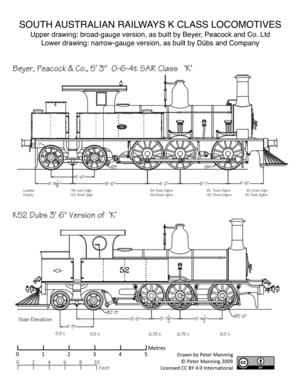| South Australian Railways K class (narrow-gauge version) | |||||||||||||||||||||||||||||||||||||||||||||||||||||||||||||||||||||
|---|---|---|---|---|---|---|---|---|---|---|---|---|---|---|---|---|---|---|---|---|---|---|---|---|---|---|---|---|---|---|---|---|---|---|---|---|---|---|---|---|---|---|---|---|---|---|---|---|---|---|---|---|---|---|---|---|---|---|---|---|---|---|---|---|---|---|---|---|---|
 Sole representative of its class on the narrow gauge, South Australian Railways K class no. 52 at Peterborough | |||||||||||||||||||||||||||||||||||||||||||||||||||||||||||||||||||||
| |||||||||||||||||||||||||||||||||||||||||||||||||||||||||||||||||||||
| |||||||||||||||||||||||||||||||||||||||||||||||||||||||||||||||||||||
| |||||||||||||||||||||||||||||||||||||||||||||||||||||||||||||||||||||
| |||||||||||||||||||||||||||||||||||||||||||||||||||||||||||||||||||||
The South Australian Railways K class (narrow gauge) comprised a single locomotive. The design, by South Australian Railways Locomotive Engineer William Thow, was very similar to that of the broad-gauge K class, but it was smaller and lighter. It was allocated number 52 within the sequence allocated to the larger locomotives.
The locomotive was built in 1883, five years after the first broad-gauge K class locomotive and a year before the last of the 18 such locomotives entered service. No. 52 was built by Dübs and Company of Glasgow, whereas Beyer, Peacock and Company, of Manchester, built all the broad-gauge class. [1] [2]
The broad-gauge design was moderately "shrunk" to meet the smaller loading gauge of 3 ft 6 in (1067 mm) lines and the lower load-bearing capacity of track compared with the 5 ft 3 in (1600 mm) broad gauge. [3] [4] [1] Some key specifications are compared in the table below.
| Some differences between the two types of K class locomotives | |||
|---|---|---|---|
| Specification | Narrow-gauge K | Broad-gauge K | Narrow/ broad proportion |
| Length over buffer beams | 28 ft 3 in (8611 mm) | 30 ft 0 in (9144 mm) | 94% |
| Driving wheels diameter | 3 ft 6 in (1067 mm) | 4 ft 0 in (1219 mm) | 88% |
| Loco weight | 32 long tons 12 cwt (73,000 lb or 33.1 t) | 42 long tons 19 cwt (96,200 lb or 43.6 t) | 76% |
| Heating surface (firebox + tubes) | 699.5 sq ft (64.99 m2) | 920.2 sq ft (85.49 m2) | 76% |
| Tractive effort | 11,063 lbf (49.21 kN) | 12,535 lbf (55.76 kN) | 88% |

A major design weakness of the broad-gauge K class was the lack of a leading bogie (pilot truck), which led to frequent derailments, especially on sharp curves and difficult gradients. A partial solution was to run the locomotives in reverse – i.e., with cab leading – so that the rear bogie led, providing guidance for the driving wheels. [3] The extent to which the weakness affected no. 52 is not known, although the presence of a stopcock on both ends of the locomotive – to take water from a four-wheeled tank wagon on longer journeys – indicates that it was able to be operated both funnel-first and cab-first.
Little is known about the service life of the locomotive; it is believed to have spent most of its half-century existence at Peterborough as a shunting engine. [1]
References
- ^ a b c Drymalik, Chris (2020). "Narrow gauge K-class 0-6-4 tank locomotives". Chris's Commonwealth railways information (ComRails). Chris Drymalik. Retrieved 10 January 2021.
- ^ Fluck, Ronald E.; Sampson, Robert; Bird, Kim J. (1986). Steam locomotives and railcars of the South Australian Railways. Adelaide, South Australia: Mile End Railway Museum (S.A.) Inc. ISBN 0959507337.
- ^ a b Williams, Hugh (2008). "The broad gauge K class locomotives of the South Australian Railways". Proceedings of the 2008 convention. Modelling the Railways of South Australia. Adelaide. p. 159.
- ^ Drymalik, Chris (2020). "Broad gauge K-class 0-6-4 tank locomotives". Chris's Commonwealth railways information (ComRails). Chris Drymalik. Retrieved 10 January 2021.